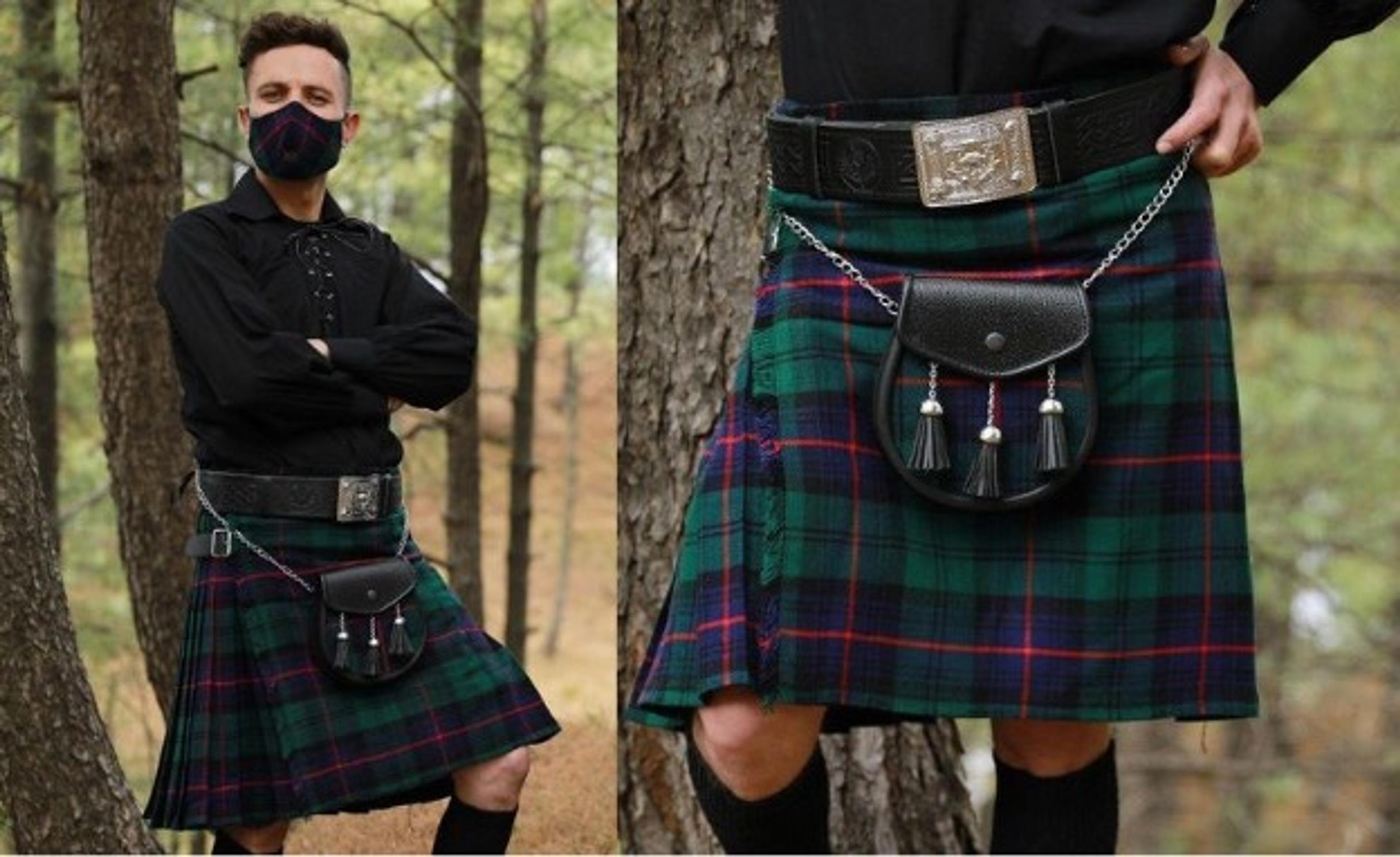The fabric of history is often woven with threads of tradition, courage, and pride. The Armstrong tartan stands as a living testament to these qualities, representing not only a pattern of cloth, but a rich tapestry of stories that have been passed down through generations. In this exploration, we delve into the origins, symbolism, and enduring significance of the Armstrong tartan, uncovering a legacy that continues to inspire and unite.
The Armstrong tartan is a striking and distinctive pattern that showcases a harmonious blend of colors. With its unique arrangement of lines and shades, the Armstrong tartan exudes an air of sophistication and individuality. This tartan design draws the eye with its balanced combination of rich hues, making it a versatile choice for various fashion and accessory items. Whether worn as a kilt, scarf, or other attire, the Armstrong tartan adds a touch of flair to any outfit, capturing attention and evoking a sense of pride. Its visual appeal and intricate design make the Armstrong tartan a popular choice for those who appreciate both tradition and contemporary style.
Unraveling the Threads of History
The Armstrong tartan, like many clan tartans, holds its roots in the Scottish Highlands. The term “tartan” itself refers to the distinct pattern of intersecting horizontal and vertical stripes, each with their own set of colors. These patterns were traditionally woven into kilts, plaids, and other forms of clothing, serving both practical and symbolic purposes.
The history of the Armstrong clan can be traced back to the borders of Scotland, an area known for its rugged landscapes and the fiercely independent clans that called it home. The clan’s name is believed to have originated from the Gaelic term “mac an Ghoill,” which means “son of the foreigner.” This name hints at the clan’s ancient roots and the mingling of different cultural influences in the region.
The Design and Symbolism of the Armstrong Tartan
The Armstrong Tartan is a tapestry of colors and patterns, each with its own significance. The tartan features a predominantly green background, representing the lush landscapes of the Scottish Borders. Running through the green are bold navy blue and black lines, symbolizing the rivers and valleys that define the clan’s ancestral lands.
The interplay of these colors is more than just aesthetic; it’s a reflection of the clan’s connection to nature and their resilience in the face of challenges. The boldness of the design speaks to the clan’s unwavering courage and determination, traits that have been passed down through the generations.
Symbolism in Stripes
The Armstrong tartan, much like other tartans, carries a language of its own through its choice of colors and pattern arrangement. The colors chosen for a tartan often have symbolic meanings, reflecting the values and history of the clan it represents.
The Armstrong tartan is predominantly composed of dark and light blue, black, and white. These colors intertwine to create a distinctive pattern that speaks to the rugged landscapes and the waters that have shaped the history of the clan. The dark blue might represent the deep lochs and the night sky, while the light blue could symbolize the rivers and the open sky. Black might evoke the strength and resilience of the clan, while white could stand for purity and honor.
Courage and Resilience
The history of the Scottish clans is often one of struggle and resilience. The Armstrong clan, like others, faced numerous challenges throughout the centuries. From territorial disputes to conflicts with neighboring clans, they navigated through a turbulent landscape. The tartan itself, with its strong and bold pattern, mirrors the tenacity of the clan members who bore it.
One of the most iconic stories associated with the Armstrong clan is the tale of Kinmont Willie. Kinmont Willie Armstrong was a notorious border reiver, known for his daring exploits. In the late 16th century, he was captured and imprisoned by the English authorities. However, the clan mounted a daring rescue mission and successfully freed him from Carlisle Castle. This act of bravery has become emblematic of the spirit of the Armstrongs, and their tartan stands as a symbol of the courage to stand up against adversity.
Pride in Identity
Tartans have always been more than just clothing; they are a visual representation of identity and belonging. The act of donning a specific tartan is a way to connect with one’s heritage and ancestors, a practice that still holds significant meaning today.
The Armstrong tartan serves as a unifying symbol for clan members, reminding them of their shared history and values. It is often worn at special occasions, gatherings, and events to display a sense of pride and solidarity. Even as times change and society evolves, the Armstrong tartan remains a powerful link to the past, fostering a sense of continuity in an ever-changing world.
Modern Revival and Global Influence
While tartans were traditionally associated with specific clans and regions, they have transcended those boundaries to become a global symbol of Scottish heritage. The Armstrong tartan, in particular, has found its way onto various products and items, from clothing to accessories, allowing individuals with Armstrong ancestry to connect with their roots in new and creative ways.
Moreover, the appeal of tartans extends beyond those with direct Scottish lineage. Many people around the world are drawn to the intricate patterns and the stories they carry. The Armstrong tartan’s blend of dark and light blues, along with its bold design, make it a visually striking choice that resonates with people seeking to connect with the spirit of courage and pride.
Preserving Tradition for Future Generations
In a world that is rapidly changing, preserving cultural traditions is of paramount importance. The Armstrong tartan is more than just a historical relic; it’s a living embodiment of a clan’s journey through time. To ensure that this legacy endures, efforts have been made to document the history behind the tartan and the stories of the clan it represents.
Additionally, organizations and societies dedicated to Scottish heritage play a crucial role in keeping these traditions alive. Through events, workshops, and educational initiatives, they provide opportunities for people to learn about tartans, their significance, and the stories behind them. This proactive approach ensures that the thread of tradition remains unbroken, weaving a connection between the past, present, and future.
The Kilt | A Garment of Tradition and Identity:
At the heart of Scottish traditional attire lies the kilt, a garment that’s as distinctive as it is versatile. The kilt is not just a piece of clothing; it’s a symbol of Scottish identity, pride, and heritage. Wearing the Armstrong Tartan kilt isn’t merely a fashion choice; it’s a way of connecting with the past, honoring one’s ancestors, and carrying their legacy into the future.
The kilt has a fascinating history, evolving from a practical garment worn by Highlanders to a symbol of Scottish culture. Its design allows for freedom of movement, making it ideal for the rugged terrains of the Scottish Highlands. Over time, the kilt became a statement of clan affiliation, with different tartans signifying different families.

Accessorizing the Tradition:
While the kilt forms the core of Scottish traditional attire, it’s the accessories that truly elevate the ensemble. From sporrans and belts to sgian-dubhs and brooches, each accessory has a story to tell.
Sporran: The sporran is a pouch that hangs from the belt and serves both a practical and decorative purpose. Traditionally used to carry essentials, it’s a nod to the resourcefulness of the Highlanders. The design of the sporran is often intricate, with details that reflect the wearer’s clan.
Sgian-Dubh: The sgian-dubh is a small dagger that’s tucked into the top of the kilt hose. Its name translates to “black knife,” and it has its roots in the Highland practice of self-defense. Today, it’s a symbol of tradition and honor.
Belt and Buckle: The belt and buckle not only hold the kilt in place but also offer an opportunity for personalization. Clan crests or symbols are often incorporated into the belt buckle design, adding an extra layer of identity.
Brooches and Pins: Brooches and pins are used to fasten the plaid or fly plaid, a length of fabric worn over the shoulder. These pieces are often exquisitely crafted, serving as both functional and ornamental additions.
Beyond Fashion: The Modern Significance:
While the Armstrong Tartan accessories are deeply rooted in history, they also have a contemporary relevance. In a world where individuality is celebrated, donning these traditional elements is a way of standing out while staying connected to one’s heritage. These accessories are a conversation starter, a way of sharing the remarkable stories of Scotland’s past with people from all walks of life.
Moreover, the popularity of Scottish festivals, Highland games, and cultural events ensures that these accessories have a place in today’s world. They are worn not only by those with Scottish ancestry but by anyone who appreciates the artistry, symbolism, and timeless appeal of these pieces.
Where to Buy All Armstong Tartan Accessories?
Discover a world of authentic Scottish heritage at the Scots Store, where enthusiasts of the Armstrong tartan can find a captivating array of accessories that pay homage to this storied lineage. From elegant scarves and cozy blankets to stylish ties and intricate bags, the Armstrong tartan is beautifully woven into each piece, reflecting a deep connection to ancestral roots. The Scots Store provides a collection of Irish Kilt for sale. With a commitment to quality and tradition, the store offers a curated selection that allows individuals to adorn themselves and their surroundings with the timeless elegance of this renowned plaid. Whether you’re drawn to its historical significance or simply captivated by its aesthetic charm, the Armstrong tartan accessories from the Scots Store provide a genuine link to the past while adding a touch of Scottish allure to the present.
In Conclusion
The Armstrong tartan is far more than a pattern; it’s a tapestry of history, courage, and pride that stretches across generations. From the rugged landscapes of the Scottish borders to the global stage, its story continues to unfold. As individuals don their kilts or incorporate the tartan into their lives, they are not only celebrating their own heritage, but also embracing the spirit of resilience that has defined the Armstrong clan for centuries. So, whether you have Armstrong ancestry or simply admire the tale it tells, the Armstrong tartan is a reminder that tradition, courage, and pride are threads that bind us all.


Comments are closed.